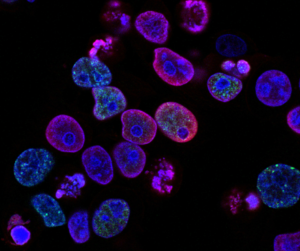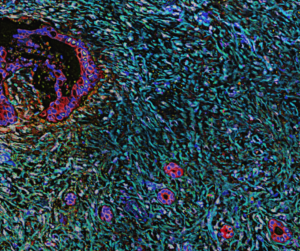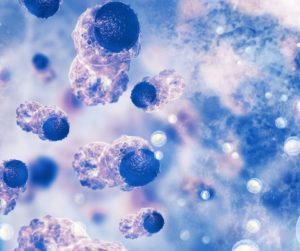Grashma Vadakkel, PharmD | Feb 10, 2021 8:18:59 AM
Bladder cancer is the sixth most common cancer in the United States. Patients with locally advanced or metastatic disease have poor long-term survival, especially those who have progressed after chemotherapy and immunotherapy. A new agent, enfortumab vedotin-ejfv (PADCEV, Astellas Pharma US, Inc.), may provide such patients with a viable and effective treatment option.
The nectin cell adhesion protein 4 (Nectin-4) is a protein often overexpressed on various tumors, including bladder tumors. Nectin-4 is suggested to be associated with oncogenic signaling pathways, promoting angiogenesis and cell proliferation, making this protein is an attractive drug target.
Recently, the Food and Drug Administration granted accelerated approval to enfortumab, the first-in-class Nectin-4 directed antibody and microtubule conjugate for adult patients with locally advanced or metastatic urothelial cancer who have previously received a programmed death receptor-1 (PD-1) or programmed death-ligand 1 (PD-L1) inhibitor, and a platinum-containing chemotherapy in the neoadjuvant/adjuvant, locally advanced or metastatic setting.
Approval was based on results of a single-arm, open-label, multicenter trial (EV-201), which included 125 patients with locally advanced or metastatic urothelial cancer previously treated with a PD-1 or PDL-1 inhibitor and platinum-based chemotherapy. Patients were excluded if they had active central nervous system metastases, ongoing neuropathy (grade ≥2), or uncontrolled diabetes defined as hemoglobin A1c ≥8% or A1c ≥7% with associated diabetes symptoms. The primary endpoint was confirmed overall response rate (ORR) by blinded independent central review. Response was determined using the Response Evaluation Criteria in Solid Tumors (RECIST 1.1).
The median age of patients was 69 years (range 40-84 years), 70% were male, 85% were Caucasian, and most patients had an Eastern Cooperative Oncology Group (ECOG) performance status of 0 or 1. The most common sites of metastases were visceral (90%) with 40% of patients having metastases to the liver. The most common histology was transitional cell carcinoma, and the medium number of prior systemic therapies was 3 (range 1-6).
Following a median duration of 10.2 months (range 0.5-16.5 months), results of the primary endpoint analysis showed an ORR of 44%, with 12% of patients achieving complete response and 32% of patients achieving partial response. Median time to response was 1.84 months (range 1.2-9.2 months). The mean duration of response was 7.6 months. Common treatment-related adverse events were fatigue (50%), any peripheral neuropathy (50%), alopecia (49%), any rash (48%), decreased appetite (44%), and dysgeusia (40%). The most common grade ≥3 treatment-related adverse events were neutropenia (8%), anemia (7%), and fatigue (6%).
The recommended dose is 1.25 mg/kg (up to maximum 125 mg for patients ≥100 kg) as an intravenous infusion on days 1, 8, and 15 of a 28-day cycle until disease progression or unacceptable toxicity.
Below are some considerations for when treating a patient with enfortumab:
Clinical pearls:
- Blood glucose: Obtain baseline hemoglobin A1c prior to starting. Patients with baseline A1 c≥8% were excluded from clinical trials. If blood glucose >250 mg/dL, withhold therapy.
- Peripheral neuropathy: Monitor for new or worsening peripheral neuropathy. Consider dose interruption or reduction if this occurs. Discontinue for grade ≥3.
- Ocular disorders: Monitor patients for ocular disorders. Consider prophylaxis of dry eyes with artificial tears and ophthalmologic evaluation if ocular symptoms reoccur or do not resolve.
- Skin reactions: Consider topical corticosteroids or antihistamines as clinically indicated.
- Infusion site extravasation: Administer as intravenous infusion over 30 minutes. Do not administer via IV bolus or IV push. Ensure adequate venous access prior to starting therapy. If extravasation occurs, stop infusion and monitor.
- Embryo–fetal toxicity: Advise female and male patients of reproductive potential to use effective contraception during treatment and for 2 months (females) and 4 months (males) after the last dose.
- Drug Interactions: Strong CYP3A4 inducers and inhibitors may affect therapeutic levels, specifically concentrations of the active monomethyl auristatin E (MMAE) component. Enfortumab is a substrate of P-glycoprotein/ABCB1.
References:
- PADCEV (enfortumab vedotin-ejfv) [package insert]. Northbrook, IL: Astellas Pharma US, Inc.; 2019 December.
- National Comprehensive Cancer Network. (2020). Bladder Cancer (version 6.2020). Retrieved from https://www.nccn.org/professionals/physician_gls/pdf/bladder.pdf
- Rosenberg, J.E., et al. (2019). Pivotal Trial of Enfortumab Vedotin in Urothelial Carcinoma After Platinum and Anti-Programmed Death 1/Programmed Death Ligand 1 Therapy. J Clin Oncol.;37(29):2592-2600. doi: 10.1200/JCO.19.01140.

Grashma Vadakkel, PharmD
PGY-2 Adult Oncology Pharmacy Resident – Memorial Sloan Kettering Cancer Center







